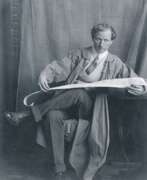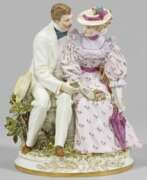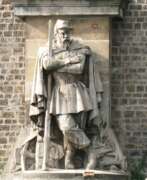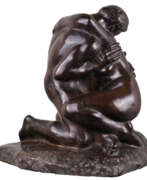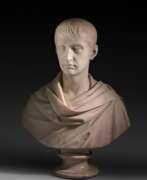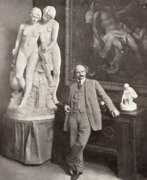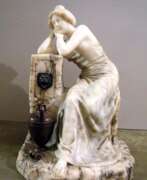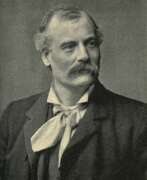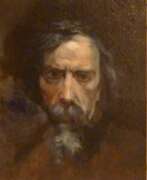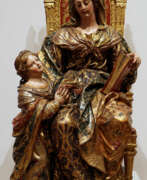Sculptors 19th century


Louise Abbéma was a French painter, sculptor, and designer, celebrated for her work during the Belle Époque. Born in Étampes in 1853 into an affluent Parisian family, she became well known for her portraits, particularly of the famous actress Sarah Bernhardt, and for decorative panels commissioned for various public buildings in Paris and the Palace of the Governor in Dakar, Senegal.
Abbéma's art often depicted the upper echelons of French society and reflected the Impressionist style through her light and rapid brushstrokes. She was also notable for her involvement in the women's movement, where she contributed to the emerging image of the 'New Woman' by portraying androgynous figures and themes of intellectualism and freedom.
Among her many honors, Abbéma was awarded the Palme Academiques in 1887, nominated as the Official Painter of the Third Republic, and in 1906, she became a Chevalier of the Legion of Honour. Her works, such as "Lunch in the Greenhouse" and "Portrait of Sarah Bernhardt," have seen a resurgence in popularity as the contribution of women to historical art gains more recognition.
For those interested in the evocative and historically rich artworks of Louise Abbéma, consider subscribing to our updates. We'll keep you informed about new sales, auctions, and exhibitions featuring Abbéma's work, ensuring you're always connected to the latest offerings in the art and antique collectors' sphere.


Antônio Francisco Lisboa, known as Aleijadinho, was a renowned sculptor, carver, and architect in Colonial Brazil. His exceptional works adorned numerous churches across the country, showcasing a style influenced by Baroque and Rococo. Considered the greatest exponent of colonial art in Brazil, Aleijadinho is recognized internationally as a leading figure in Baroque art in the Americas.
Despite limited biographical information, his contributions are celebrated through the vast body of work he left behind. His creations, including carvings, architectural projects, reliefs, and statues, were concentrated in Minas Gerais, notably in Ouro Preto, Sabará, São João del-Rei, and Congonhas. The Church of Saint Francis of Assisi in Ouro Preto and the Sanctuary of Bom Jesus of Matosinhos showcase some of his most significant works.


André-Joseph Allar was a French sculptor. He studied at the Schools of Fine Arts in Marseille and Paris with Eugène Guillaume, Antoine Laurent Dantan and Pierre-Jules Cavelier.
André-Joseph Allar is best known for his small works and architectural projects.


Nikolay Andreyevich Andreyev (Russian: Николай Андреевич Андреев) was a distinguished Russian sculptor, graphic artist, and stage designer, whose works have significantly contributed to the artistic landscape of early 20th-century Russia. Born into the rich cultural milieu of Moscow in 1873, Andreyev emerged as a pivotal figure associated with the Peredvizhniki group, a movement that sought realism and social critique through art. His early education under Sergey Volnukhin paved the way for a career that spanned various forms of artistic expression, including sculpture and graphic design.
Andreyev's works are known for their dynamic representation of figures and profound social commentary. Perhaps his most famous creation is the bronze statue of the celebrated writer Nikolai Gogol, unveiled in 1909. This statue, surrounded by bronze friezes depicting Gogol's characters, initially stood on Gogol Boulevard in Moscow. Its impressionistic style, however, attracted criticism, leading to its relocation in 1952. Another notable work, the "Woman reaper with a child," showcases Andreyev's adeptness at capturing the essence of Russian cultural symbols through sculpture. Cast in bronze, this work reflects Andreyev's ability to convey complex themes such as motherhood and labor with sensitivity and depth.
In his later years, Andreyev's artistic direction veered towards Socialist Realism, producing a prolific array of Leniniana - sculptures and graphic works of Vladimir Lenin. His commitment to this genre was profound, with around 100 sculptures and 200 graphic works dedicated to Lenin, marking a significant contribution to Soviet artistic propaganda. Additionally, his portrait of Lev Tolstoy stands as a testament to his versatility and depth as an artist, capturing the essence of the literary giant with striking realism.
Andreyev's legacy extends beyond his artistic achievements, with his works residing in prestigious collections such as the Tretyakov Gallery. His death in 1932 marked the end of a vibrant chapter in Russian art history, but his contributions continue to be celebrated for their artistic merit and historical significance.
For collectors and experts in art and antiques, the works of Nikolay Andreyevich Andreyev offer a unique glimpse into the cultural and political nuances of Russia during a transformative era. His sculptures not only stand as remarkable feats of artistic expression but also as enduring symbols of Russia's rich cultural heritage.
If you're intrigued by Andreyev's profound contributions to art and wish to explore his works further, consider signing up for updates. This subscription will keep you informed about new product sales and auction events related to Nikolay Andreyevich Andreyev, offering exclusive insights into the world of art and antiques.


Mark Matveyevich Antokolsky (Russian: Марк Матве́евич Антоко́льский) was a 19th century Russian sculptor and writer. He is known as a representative of the realistic style and as the first sculptor of Jewish origin to gain international fame.
Mark Antokolsky devoted most of his career to the depiction in marble, plaster and bronze of the real characters of Russian history and achieved wide recognition already at a young age. His works were highly appreciated not only in Russia but also abroad and the artist was elected a member of many European academies of arts.
Mark Antokolsky was also a very successful writer. He often wrote publicistic articles on the development of the visual arts, and shortly before his death he published a novel describing real-life events in the life of the Jews in the Russian Empire.
Although from the early 1870s Mark Antokolsky spent most of his time living in France, he never lost touch with Russia - he constantly carried out orders for the royal family and the Russian Academy of Arts, wrote articles for Russian magazines, and regularly held solo exhibitions of his works in St. Petersburg.


Hezekiah Augur was an American sculptor and inventor. He was self-taught and, unlike many other American sculptors of the 19th century, spent his entire career in New Haven.
Hezekiah Augur was the son of a carpenter and learned the woodcarving trade early on. He later invented a lace loom and a machine for carving piano legs. He then switched to marble.
Hezekiah Augur was a member of the Connecticut Academy of Arts and Sciences.


Edward Hodges Baily was a prolific English sculptor responsible for numerous public monuments, portrait busts, statues and exhibition pieces as well as works in silver. He carved friezes for both the Marble Arch and Buckingham Palace in London. His numerous statues of public figures include that of Horatio Nelson on top of Nelson's Column and Charles Grey, 2nd Earl Grey on Grey's Monument in Newcastle upon Tyne. Throughout his career Baily was responsible for creating a number of monuments and memorials for British churches and cathedrals, including several in St Paul's Cathedral.
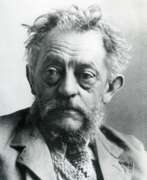

Ernst Heinrich Barlach was a German expressionist sculptor, medallist, printmaker and writer. Although he was a supporter of the war in the years leading to World War I, his participation in the war made him change his position, and he is mostly known for his sculptures protesting against the war. This created many conflicts during the rise of the Nazi Party, when most of his works were confiscated as degenerate art. Stylistically, his literary and artistic work would fall between the categories of twentieth-century Realism and Expressionism.


Louis-Ernest Barrias was a French sculptor of the Beaux-Arts school. In 1865 Barrias won the Prix de Rome for study at the French Academy in Rome.
Barrias was involved in the decoration of the Paris Opéra and the Hôtel de la Païva in the Champs-Élysées. His work was mostly in marble, in a Romantic realist style indebted to Jean-Baptiste Carpeaux.




Heinrich Baucke was a German sculptor renowned for his neo-baroque masterpieces, flourishing at the turn of the 20th century. Born in Düsseldorf on April 15, 1875, Baucke dedicated his life to the creation of statues and memorials that captured the nobility and distinguished figures of his time.
Trained at the Kunstakademie Düsseldorf under the tutelage of Karl Janssen from 1891 to 1900, Baucke's sculptures won him first prizes in competitions, solidifying his reputation as a preeminent artist. His works, primarily in bronze, are celebrated for their intricate detail and evocative presence. One of his earliest successes, "The Victorious Boxer" created in 1897, today stands in the Kunsthalle Düsseldorf, a testament to his skill and artistic vision.
Baucke's creations are not just pieces of art; they are historical dialogues in metal, with works like the bust of German Emperor Wilhelm I and the statue of King Friedrich I adorning public spaces, bridging the past with the present. His death on April 12 or 13, 1915, in Ratingen, marked the end of an era for German neo-baroque sculpture.
For collectors and art historians, Baucke's works offer a glimpse into the neo-baroque sensibilities of a bygone era. His sculptures, which often graced public spaces and exhibitions, now hold a place of honor in galleries and are sought after in auctions for their historical and artistic value.
Explore the legacy of Heinrich Baucke by signing up for our newsletter, and seize the opportunity to collect pieces from one of the neo-baroque's finest sculptors.


Reinhold Begas was a German sculptor of the second half of the 19th century. He is known as a representative of the neo-baroque style of the Berlin school of sculpture. Many of Begas' works still adorn squares in Berlin and other German cities today.
Reinhold Begas was the most famous representative of the family dynasty of painters and sculptors. His father Carl Joseph Begas, his brothers Carl Begas, Oskar Begas and Adalbert Begas and his eldest son Werner Begas all left their mark on German culture.
Reinhold Begas was one of the first professors at the Weimar School of Art. Until his death, the sculptor was a member of the Association of German Artists and a professor at the National Academy of Art.
During his lifetime, Begas created hundreds of works, including statues, busts, tombstones and bas-reliefs, but many of them were later destroyed during wars, revolutions and regime changes, including for political reasons.


Fritz Behn, full name Max Adolf Friedrich Behn, is a German sculptor and graphic artist who became famous primarily for his sculptures of African animals. He studied at the Munich Academy of Fine Arts.
Fritz Behn was a member of the Munich Secession.




Treffle Berthlaume was a Canadian sculptor. He specialised in woodcarving and created the Barbeau Cross, which is now on display in the Saint-Jean Church on Orleans Island in Quebec.
Treffle Berthlaume was honoured with a 32-cent Canadian stamp in 1984, 100 years after his death.


Karl Bitter was an American sculptor of Austrian origin. He is known as a master of neoclassicism in the late 19th and early 20th centuries. Bitter became famous for his decorative relief decorations on the facades of municipal buildings and private residences. Among the creative achievements of the master are also numerous monuments to prominent compatriots.
Karl Bitter was one of the most successful immigrant artists in U.S. history. During his lifetime, he received many awards from the American government, and shortly before his tragic death at the age of 47, he was elected president of the National Society of Sculptors of the United States.


Karl Blossfeldt was a German photographer, sculptor and teacher who worked in Berlin. He was one of the representatives of the New Vision in photography. Blossfeldt worked with a camera of his own invention that allowed him to reach a 30x magnification.
He photographed mainly flowers, plants and plant fragments. Under this magnification plants resemble abstract shapes rather than the plant itself. Blossfeldt's photographs can be equally classified as scientific photography and as works of art.


Richard Walter Bock was an American sculptor and associate of Frank Lloyd Wright. He studied art in Europe: at the Berlin Academy and the École des Beaux-Arts in Paris.
Richard W. Bock won a competition to create an exterior sculpture at the Indianapolis Public Library in 1892. He became head of the sculpture department at the University of Oregon in 1929.
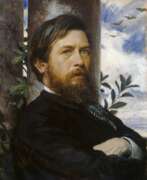

Arnold Böcklin was a Swiss symbolist painter.
Influenced by Romanticism, Böcklin's symbolist use of imagery derived from mythology and legend often overlapped with the aesthetic of the Pre-Raphaelites. Many of his paintings are imaginative interpretations of the classical world, or portray mythological subjects in settings involving classical architecture, often allegorically exploring death and mortality in the context of a strange, fantasy world.


Emile André Boisseau was a French sculptor.
He studied sculpture at the École des Beaux-Arts under Dumont and Bonnacier and has exhibited regularly at the Salon since 1879. Boisseau worked with bronze, onyx and other materials, creating busts, group compositions on mythological and religious subjects. Boisseau was an officer of the Legion of Honor.
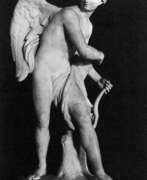

Louis-Simon Boizot was a French artist of the second half of the 18th and early 19th centuries. He is known as a sculptor of the neoclassical style. Boizot was widely famous for the production of busts of prominent people of France and multi-figure sculptural compositions of Sevres porcelain.
Louis-Simon Boizot is the most famous representative of the family dynasty of artists. His father Antoine Boizot was a painter and his younger sister, Marie-Louise-Adelaide Boizot, a draftsman and engraver. Louis-Simon Boizot enjoyed the special patronage of King Louis XVI and Queen Marie-Antoinette, while the Russian Empress Catherine II personally ordered original porcelain pieces from the master.
Boizot was also often engaged in the manufacture of sculptural decorations for the public buildings of Paris - churches and palaces. He mastered the techniques of processing a variety of materials and created masterpieces not only of marble, but also of porcelain and bronze.
In 1805 Boizot was appointed head of the French National Academy of Arts.


François Joseph Bosio was a French Neoclassical sculptor.
François Joseph Bosio was a pupil of the sculptor Augustin Pajou. With the support of the latter he made a study trip to Italy, where he studied statues by antique masters. He was also court sculptor to Kings Louis XVIII and Charles X.
At that time, he was favored by the French monarchs: Napoleon I decorated him with the Legion of Honor, Louis XVIII awarded him with the royal order of Saint Michail, he became an Institute of France member (in 1816) and in 1822, was granted the title of royal sculptor.
He was the director of the Academy of Fine Arts in Paris. The influence of Antonio Canova is noticeable in his sculptures.


Henri Bouchard is a twentieth-century French sculptor. Henri Bouchard is known as an outstanding representative of realism, a medallist and engraver.
During his professional career Henri Bouchard created a great number of original works: monumental monuments, reliefs, busts, tombstones, statues and decorative elements of buildings. The master's work had a marked influence on the development of sculpture in France in the interwar period.


Jean Boucher was a French sculptor from the late 19th century to the first half of the 20th century. He is known as a master of monumental fine art.
Jean Boucher is best known for the creation of war memorials, his work now adorns the squares of many cities in France. But the sculptor's creative legacy is not limited to war memorials. Boucher also created many monuments to prominent French people - poets, writers, political and military figures, inventors and aviators. At the 1925 World's Fair, he was awarded the highest award for his invaluable contribution to world art, and by the end of his life he was a full cavalier of the French Legion of Honor.
For many years, Boucher combined his active creative work with the education of his young colleagues. As a full member of the French National Academy of Arts, he willingly shared his knowledge with students and enjoyed great prestige among them. Despite serious health problems, the sculptor actively continued to work until his death.


Emile Antoine Bourdelle was an influential and prolific French sculptor and teacher. He was a student of Auguste Rodin, a teacher of Giacometti and Henri Matisse, and an important figure in the Art Deco movement and the transition from the Beaux-Arts style to modern sculpture.
His studio became the Musée Bourdelle, an art museum dedicated to his work.


Constantin Brâncuși was a Romanian sculptor, painter, and photographer who made his career mainly in France, becoming one of the pivotal figures of modern sculpture and a pioneer of modernism. Born in 1876 in Hobița, Romania, Brâncuși displayed a talent for carving from a young age, a skill honed during his early life as a shepherd in the Carpathian Mountains. His work evolved from traditional forms to groundbreaking abstract sculptures that sought to capture the essence rather than the literal representation of his subjects.
After moving to Paris in 1904, Brâncuși's unique style began to take shape. He worked briefly in the studio of Auguste Rodin, but soon left to pursue his own vision, stating that "Nothing can grow under big trees." This decision marked the beginning of his pursuit to distill forms to their simplest essence, a philosophy that would define his career. Brâncuși's sculptures, such as "The Kiss" and "Bird in Space," are celebrated for their smooth, simplified forms that evoke the core of the subject matter with minimal detail. His work in wood, bronze, and marble often carried a serene, timeless quality, blending modernist aesthetics with a touch of his Romanian heritage.
Brâncuși's contributions to art were not limited to sculpture. He was also an accomplished photographer, using his camera to capture the spatial relationships and compositions of his studio and sculptures, an extension of his artistic vision. His works are held in high regard worldwide and are featured in prominent collections, such as the Museum of Modern Art in New York and the Tate in the United Kingdom.
The legal battle over "Bird in Space" in 1927 highlighted the challenges Brâncuși faced in having his work recognized as art by traditional standards. This case, which eventually ruled in his favor, established a precedent for modern art's recognition beyond traditional forms and representations.
For art collectors and experts, Brâncuși's oeuvre represents a bridge between the tactile craftsmanship of earlier periods and the conceptual, form-driven concerns of modern art. His legacy is a testament to the power of innovation, vision, and the enduring appeal of simplicity in form.
For those interested in the evolution of sculpture and the role of art in transcending cultural and temporal boundaries, Constantin Brâncuși's work offers profound insights. We invite you to sign up for updates on new product sales and auction events related to Brâncuși's work, ensuring you stay informed about opportunities to engage with the legacy of this pioneering artist.


Georges Braque, a French artist, is celebrated as a pivotal figure in the development of Cubism, alongside Pablo Picasso. Braque's artistic journey transitioned from Impressionism to Fauvism before he delved into the groundbreaking realm of Cubism, characterized by its innovative use of perspective and geometric forms. His partnership with Picasso during the early 20th century marked a significant phase in art history, as they collectively pioneered the Analytic and Synthetic phases of Cubism.
Georges Braque's oeuvre is renowned for its technical precision, introspective quality, and harmonious color palettes. His contributions extended beyond painting to include sculpture and collage, demonstrating his versatile mastery over various mediums. Notable works like "Violin and Candlestick" and "Man with a Guitar" underscore his talent in transforming everyday objects into abstracted, multifaceted compositions.
Throughout his career, Georges Braque remained deeply committed to exploring the boundaries of visual perception and form. After World War I, his style evolved, incorporating brighter colors and new themes, yet he maintained a steadfast adherence to Cubist principles. His later years saw a focus on personal motifs, such as birds, which symbolized freedom and dynamism in his art.
Georges Braque's legacy is preserved in prestigious collections worldwide, including the Museum of Modern Art (MoMA), which houses a significant number of his works. His artistic innovations continue to inspire and influence the realms of art and culture.
For collectors and art enthusiasts, Georges Braque's work offers a profound insight into the evolution of modern art and the enduring allure of Cubism. His pieces are a testament to the enduring power of creativity and innovation in the face of changing artistic landscapes.
If you're keen on exploring Braque's contributions to art and wish to stay updated on exhibitions and sales featuring his work, consider subscribing for updates on Georges Braque's pieces and their presence in the art market today.


Solyman Brown was an American dentist, creator of the first U.S. National Dental Society and the first U.S. Dental Journal, as well as a poet and artist.
Brown received his bachelor's, master's, and doctor of medicine degrees from Yale University, and also worked as a minister. He wrote many articles explaining dental principles and regulations and became one of the editors of the American Journal and Library of Dental Sciences.
Essentially, in the 19th century, American dentistry was in a terrible state. And Solyman Brown, through all his activism, contributed to the enlightenment and establishment of dentistry in the United States as a true profession and science.
Brown also wrote poetry, articles and essays, and was constantly published in the periodical press. He gained fame and notoriety as a dental poet with his epic "Dentology, a poem on the diseases of the teeth and their proper remedies," which he wrote in 1833. And many more of his poems were devoted to dental diseases, their prevention and treatment. Soliyman Brown, in addition, was a painter and sculptor, painting portraits and creating furniture in wood.




Louis Gustave Cambier is a Belgian painter-painter and sculptor, member of the Royal Academy of Fine Arts in Brussels.
Cambier studied at the Royal Academy of Fine Arts in Brussels and was a co-founder of the Brussels artists' group Le Labeur. During the First World War, he worked as a professor of sculpture at the Académie de Nice and one of his students was Henri Matisse.
Cambier painted landscapes, still lifes and genre scenes, as well as portraits of famous contemporaries, including, for example, a portrait of Winston Churchill.


Antonio Canova was an Italian sculptor of the late 18th and early 19th centuries. He is known as a bright representative of neoclassicism in European fine art. Canova was a follower of traditions of artists of antiquity and Renaissance. Among admirers of his creativity there were many representatives of ruling dynasties of Europe.
Antonio Canova himself created more than 50 statues, and together with his assistants - about 180 works. He gained influential patrons and had a reputation as the most important European sculptor of his time. Among his customers was Napoleon Bonaparte, whose statue Canova carved from marble, depicting the emperor as Mars.
Most of Canova's works today decorate the expositions of the world's leading museums, such as the halls of the Louvre and the Hermitage.


Louis-François Cassas was a distinguished French landscape painter, sculptor, architect, archeologist and antiquary.
Besides his architectural and archaeological drawings and sketches, he drew numerous costumes studies, views and processions, as well as scenes from daily life, plants and animals of all sorts. He also exhibited views of his travels at the "Salons", which were periodic art exhibitions sponsored by the French Académie Royale, in 1804 and 1814, and published Picturesque views of the Principal Sites and Monuments of Greece, of Sicily, and of the Seven Hills of Rome, of which thirty parts had already been published by 1813.


Giannino Castiglioni was an Italian sculptor and medallist. He worked mostly in monumental and funerary sculpture; his style was representational, and far from the modernist and avant-garde trends of the early twentieth century.


Pierre-Jules Cavelier was a French sculptor and teacher. Member of the Académie Française des Beaux-Arts. He studied sculpture with David d'Angers and painting with Paul Delaroche.
Pierre-Jules Cavelier won the Prix de Rome of the Académie Française in 1842. He was the author of numerous sculptural decorations of public, religious and residential buildings and structures in Paris. Chevalier of the Legion of Honour.
















